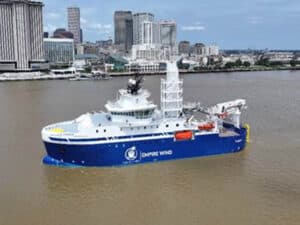
OPINION: Offshore wind—the fallacy of just this once
Written by Marine Log Staff
Aaron Smith, President of OMSA
By Aaron C. Smith, President of the Offshore Marine Service Association
At home, I live in a near constant state of “just this once.” From YouTube and TikTok, to desserts and kittens, every request my kids, Campbell (9) and Mazie (7), make is prefaced with this obviously inaccurate disclaimer. While I’m not the quickest to pick up on trends, I’ve learned to distrust the “temporary” nature of these requests.
Unfortunately, work is not a respite from “just this once” promises. Most recently, the requests have come from some in the offshore wind community, who attempt to leverage the urgency of the perpetually impending U.S. offshore wind market to delay U.S. mariners and workers’ realization of the benefits provided by this industry.
Specifically, these actors seek a Jones Act leniency of “just this once” so that the first projects can be built by foreign-flagged vessels, manned by foreign mariners, and operated by foreign-owned companies.
Coming from the Gulf of Mexico offshore energy industry, we at the Offshore Marine Service Association (OMSA) are hesitant to believe this request. In our history, we have seen two distinct Jones Act enforcement regimes and, as a result, two distinct domestic market reactions.
From 1976 through 2009, our industry was subjected to a vicious cycle where foreign subsea construction vessels exploited “just this once” bureaucrat-created loopholes in the Jones Act to undercut U.S. vessels. These supposedly short-term waivers provided a long-term chilling effect on U.S. investment in this market. The resulting lack of U.S. equipment led foreign vessel owners to request more bureaucratically created loopholes, claiming the U.S. market could not satisfy the industry’s requirements and the cycle continued from there.
In other markets—and time periods—we have seen the Jones Act be correctly applied, breeding market certainty and transparency, which, in turn, has promoted continued investment and construction in U.S. shipyards.
As specific examples, I point to the following.
At one time, the U.S. fleet did not contain the barges necessary to transport oil platforms from the shipyard to the Outer Continental Shelf. To correct this problem, Congress passed a law creating a transparent process where if project sponsors could demonstrate there was not a sufficient U.S. vessel, they were permitted to use a foreign vessel. Conversely, the provision assured U.S. owners if they constructed this equipment, their commitments would be honored. As a result, they invested in U.S. equipment and displaced the foreign barges.
Subsequently, in 2009, Customs & Borders Protection (CBP) gave U.S. vessel operators the impression that they would correct the previously described Jones Act loopholes in the subsea construction market. Based upon this signal, U.S. companies devoted more than $2 billion employing Americans in U.S. shipyards to build vessels for this work. These U.S. companies built so many U.S.-flagged subsea construction vessels that the trade association for the foreign vessel owners that had once said the U.S. industry could not supply this market, were forced to report, U.S. vessels had “largely displaced the foreign tonnage. … This market adjustment is normal and poses no threat to future investment and development in the U.S. [Gulf of Mexico]”
And finally, we have seen an explosion in U.S. dredge construction. These newbuilds directly follow Congress’ increased utilization of the Harbor Maintenance Trust Fund, thereby increasing the U.S. Army Corps of Engineers maintenance dredging budget.
In each of these instances, it is clear that when lawmakers and government officials provided an assurance that there would be a rational and transparent market that correctly enforced the Jones Act, vessel owners actively and overwhelmingly responded, building to the market. In doing so, these owners created opportunities for U.S. mariners, shipyard workers, and suppliers. In short, when enforced, the Jones Act works as intended.
Unfortunately, some—but certainly not all—of our friends in the offshore wind space have not reviewed this history and are now claiming shortfalls in U.S. capabilities and requesting “just this once” waivers.
OMSA disagrees with this philosophy. History—and my children—shows that “just this once” too easily metastasizes into a near permanent loss of markets. Conversely, transparency and certainty time and again breed domestic investment that fully fulfills every market.
To this end, OMSA was proud to work with Congress last year to enact language as part of the National Defense Authorization Act (NDAA) confirmed the Outer Continental Shelf Lands Act, and therefore the Jones Act, applies to offshore wind farms in federal waters.
Just as it has before, this certainty-instilling act gave the industry the confidence to invest, already yielding announcements of new U.S. vessel construction.
Considering all of these facts, let’s be strong and not give in to the “just this once” requests and instead provide the certainty and predictability to the U.S. maritime industry so it can do what it has always done: build to a market and employ American workers.




